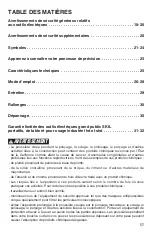
12
Installing and Removing the
Microfilter Dust Canister (Fig. 4)
WARNING
Always disconnect the plug
from the power source
before installing or removing the microfilter
dust canister.
To install the microfilter dust canister, align
the slot on the dust canister with the rib on
the tool, and then push the dust canister onto
the tool until it locks into place. To remove the
microfilter dust canister, simply pull the dust
canister away from the tool.
Cleaning and Emptying the Dust Canister
Knock excess dust out of the microfilter or remove the dust with your fingers or a soft brush
(not included). You may notice that all the dust may not come out of the canister. This will not
affect sanding performance but will reduce dust collection efficiency.
NOTE: Do not wash the micro filter with soap and water. Dust may become more firmly lodged
in the pores, which will reduce dust collection, and damage the microfilter.
Sanding Tips
This tool is particularly suitable for one-hand- operation and provides access to corners and
edges that are otherwise difficult to reach.
Always be certain that smaller workpieces are securely fastened to a bench or other support.
Larger panels may be held in place by hand on a bench or sawhorses.
SANDING: Open-coat aluminum oxide sanding sheets are recommended for most wood or
metal sanding applications, as this synthetic material cuts quickly and wears well.
For best results, use sanding accessories which are of superior quality and are carefully
selected to produce professional quality results with your sander.
The following suggestions may be used as a general guide for abrasive selection, but the best
results will be obtained by sanding a test sample of the workpiece first.
Grit
Application
Coarse
For
rough wood or metal sanding, and removal of rust or old finish.
Medium
For
general wood or metal sanding
Fine
For
final finishing of wood, metal, plaster and other surfaces.
Extra fine
For
final sanding of bare wood, smoothing old paint, or preparing a finished
surface for recoating.
Fig. 4













































